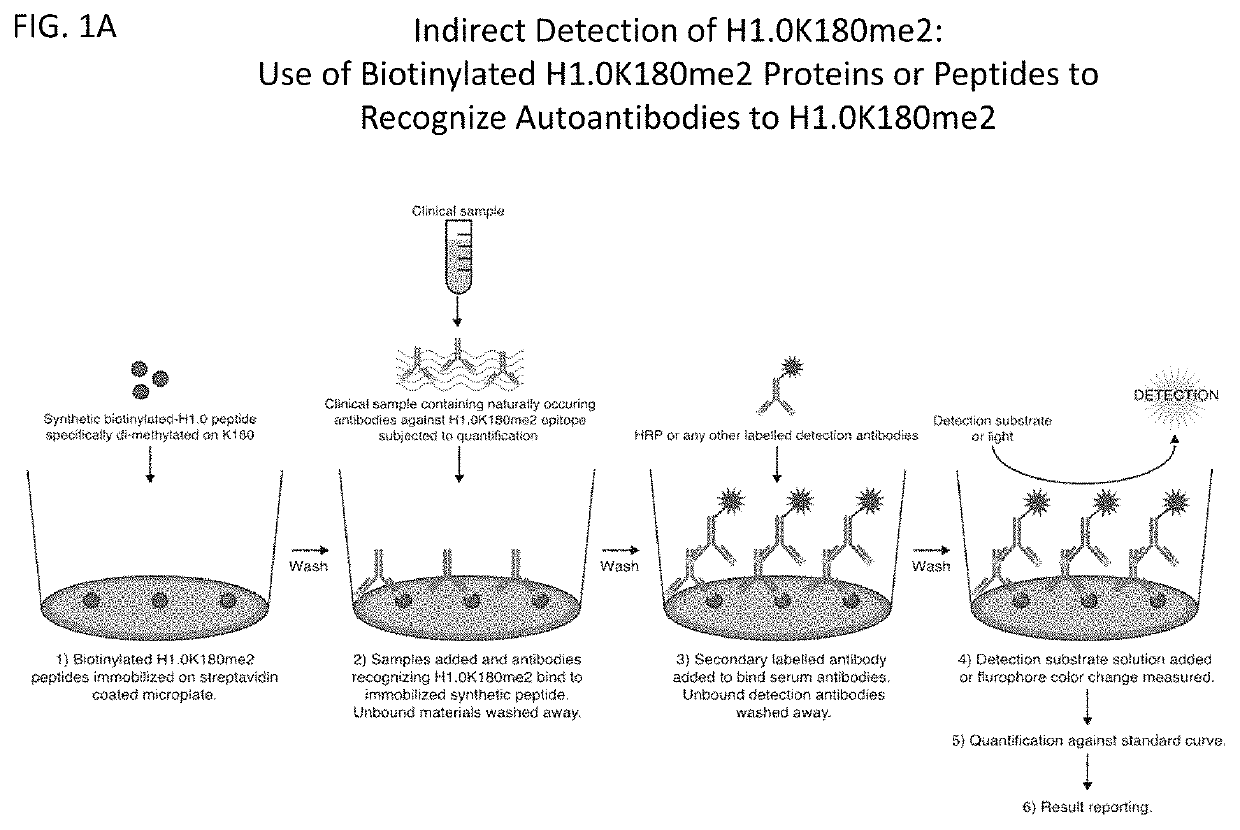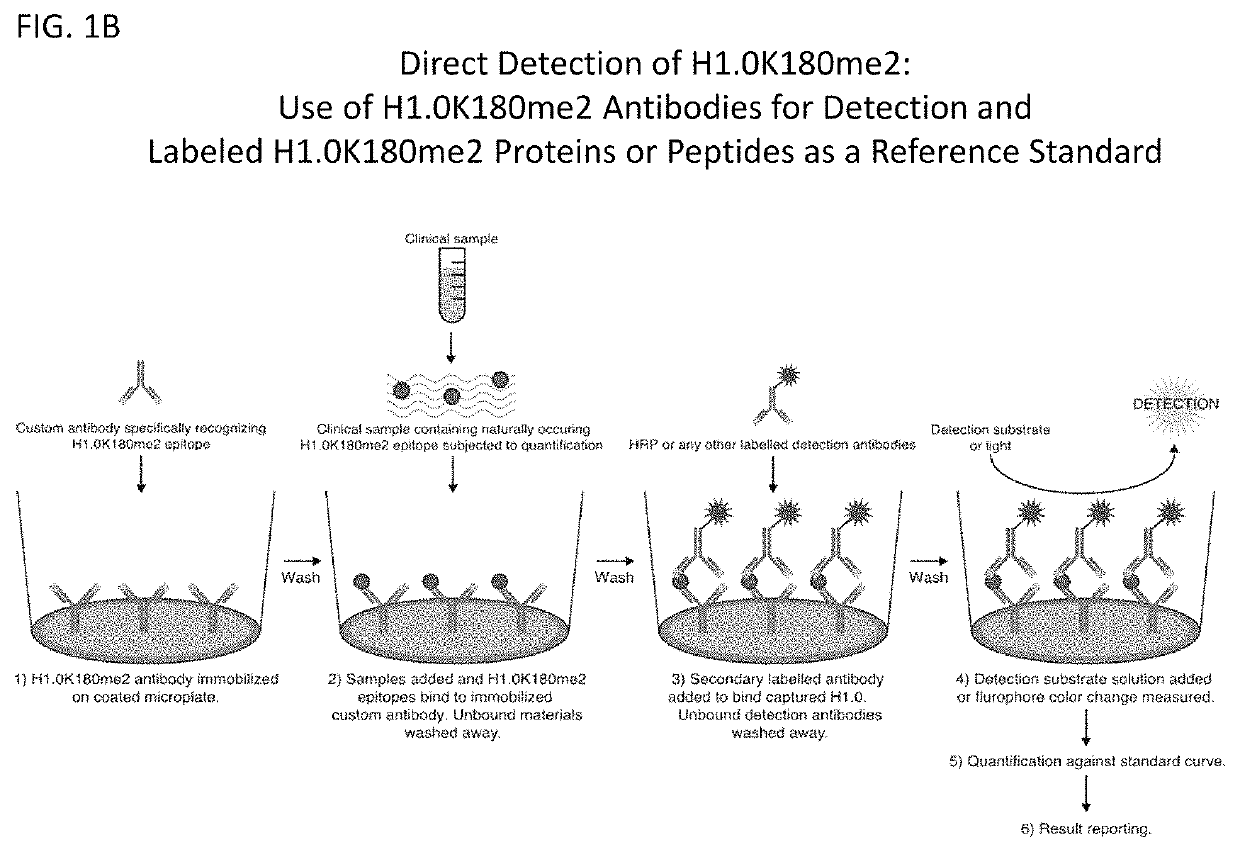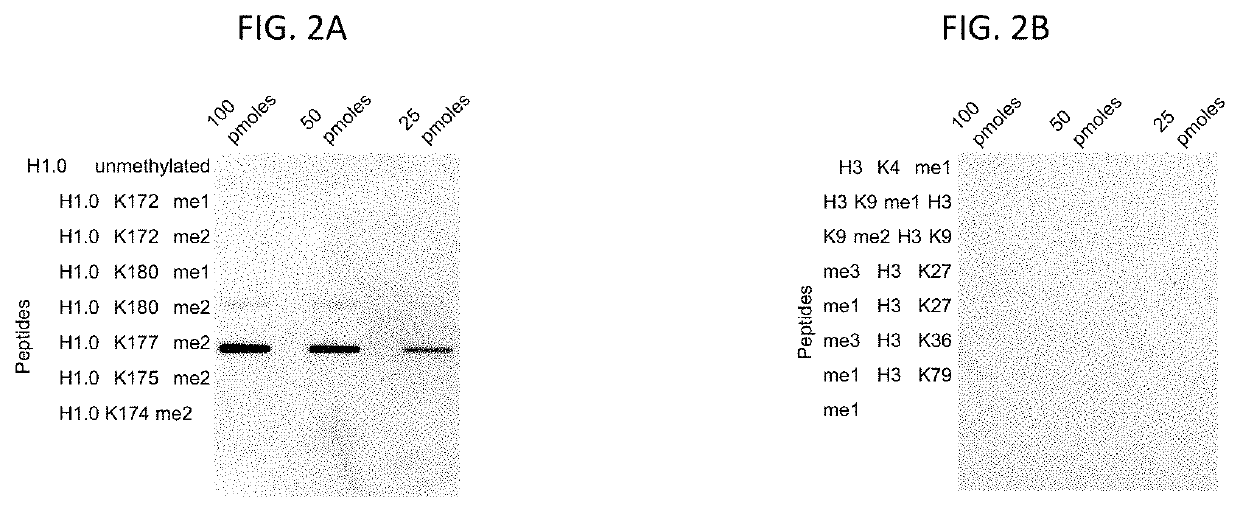Compositions and methods related to the methylation of histone H1.0 protein
a technology of histone h1.0 and methylation, which is applied in the direction of transferases, peptide sources, instruments, etc., can solve the problems that the ability of kmt to recognize a specific lysine residue cannot be predicted by primary structure alone or deduced
- Summary
- Abstract
- Description
- Claims
- Application Information
AI Technical Summary
Benefits of technology
Problems solved by technology
Method used
Image
Examples
example 1
and Methods
[0176]Provided here are materials and methods used in the subsequent examples.
In Vitro Methylation of H1.0 Protein and Peptides—Radiolabel in Vitro Methylation Assay
[0177]In order to visualize methylation of H1.0 peptide by G9A methyltransferase in vitro, a methylation assay was performed incorporating a radiolabelled methyl donor, which allows for visualization of methylated peptide on a gel after autoradiography exposure. The following methylation reaction was set up in a 1.5 ml tube: 1×HMT reaction buffer (50 mM Tris-HCl, 5 mM MgCl2, 4 mM dithiothreitol, pH 9.0), 10U G9A Methyltransferase (NEB, M0235S, Lot #0031201), 3.2 mM Adenosyl-L-Methionine, S-[Methyl-3H] (Perkin Elmer, NET155H, Lot #1664720), 10 μg H1.0 peptide (ThermoFisher Scientific, Biotin-AKPVKASKPKKAKPVKPK (SEQ ID NO:69)), final volume 10 μl. A control reaction as above but without H1.0 peptide was also created. Reactions were incubated in a thermocycler at 37° C. for 1 hour. Reactions were stopped by incub...
example 2
Methylation with G9A and Analysis of Products
[0205]FIGS. 8A-8B show the results of this in vitro G9A methylation assay.
[0206]A G9A methyltransferase is capable of methylating an H1.0 peptide (FIG. 8A). The methylation reaction was subsequently resolved on a gel and visualized via autoradiography. The appearance of a band at 4 kDa shows that The G9A methyltransferase capable of methylating H1.0 peptide through the transfer of tritium-labeled methyl groups to the peptide, allowing for visualization. A control reaction lacking H1.0 peptide yielded no tritium-labeled products.
[0207]A G9A methyltransferase is capable of methylating a full-length recombination H1.0 (FIG. 8B). An in vitro methylation assay of recombinant full-length histone H1.0 with increasing amounts of G9A is shown in FIG. 8B. G9A is capable of dimethylating full length H1.0 at K180.
[0208]In order to identify the precise locations of G9A methylation on an unmodified H1.0 peptide (AKPVKASKPKKAKPVKPK (SEQ ID NO:36)), a me...
example 3
Methylation with GLP and Analysis of Products
[0211]In order to identify the precise locations of GLP methylation on unmodified H1.0 peptide (AKPVKASKPKKAKPVKPK (SEQ ID NO:36)), a methylation reaction was set up and the products identified by LC-MS. The methylation reaction comprised recombinant GLP, an unlabeled methyl donor (S-Adenosyl-L-Methionine), and unmodified H1.0 peptide. The methylation reaction was subsequently analyzed by LC-MS, and each spectral peak (corresponding to a peptide species in the final reaction) was identified and quantified using spectral counts. The number of “me” circles in FIG. 12 represents the methylation state of the lysine residue (mono-, di-, or tri-methylated). FIG. 12 shows that in the presence of unmethylated H1.0 peptide, GLP specifically dimethylates H1.0K180 (96.6% of all peptides).
[0212]In order to identify the precise locations of GLP methylation on K180 dimethylated H1.0 peptide (AKPVKASKPKKAKPVK(me2)PK (SEQ ID NO:3)), a methylation reactio...
PUM
| Property | Measurement | Unit |
|---|---|---|
| genotoxic stress | aaaaa | aaaaa |
| dissociation constant | aaaaa | aaaaa |
| dissociation constant | aaaaa | aaaaa |
Abstract
Description
Claims
Application Information
 Login to View More
Login to View More - R&D
- Intellectual Property
- Life Sciences
- Materials
- Tech Scout
- Unparalleled Data Quality
- Higher Quality Content
- 60% Fewer Hallucinations
Browse by: Latest US Patents, China's latest patents, Technical Efficacy Thesaurus, Application Domain, Technology Topic, Popular Technical Reports.
© 2025 PatSnap. All rights reserved.Legal|Privacy policy|Modern Slavery Act Transparency Statement|Sitemap|About US| Contact US: help@patsnap.com



